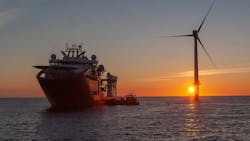Analysis: Offshore wind market remains ‘steady’ amid political shifts
The offshore wind sector continues to grow globally, with service operation vessels (SOVs) and construction service operation vessels (CSOVs) playing increasingly important roles, according to a recent analysis from Intelatus Global Partners.
Interest in purpose-built SOVs and CSOVs has surged due to the expansion of offshore wind farms, particularly across Europe. According to Intelatus Global Partners, the current fleet of approximately 60 vessels is projected to double by 2028, reflecting growing demand for vessels capable of supporting large-scale, further from shore offshore operations.
While crew transfer vessels (CTVs) remain effective for near shore and/or smaller wind farms, the increasing size and complexity of offshore projects underscore the need for specialized SOVs and CSOVs.
“The offshore wind industry is evolving rapidly,” said Phil Lewis, Director of Research at Intelatus. “SOVs are typically built against long-term charters, ensuring balanced supply-demand dynamics. In contrast, CSOVs, often constructed speculatively, cater to shorter duration construction and commissioning projects. Aggressive investment in CSOVs is likely to lead to oversupply in the short- to mid-term and impact dayrates.”
